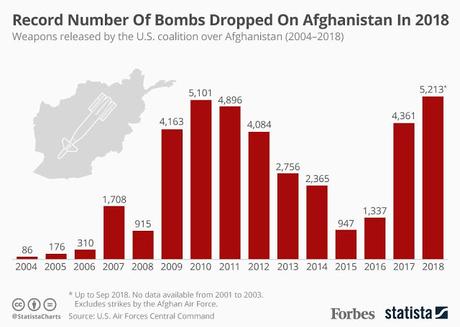
The chart above (from Forbes.com) shows the number of bombs dropped on Afghanistan by year (between 2004 and 2018). Note that 2018 has the record for the number of bombs dropped, and we still have a month and a half to go in 2018. If you thought the war was winding down in that country, that graph should wake you up.
But those bombs in Afghanistan represent only a fraction of spending on wars in Asia and the Middle East since 2001. The actually spending on those seemingly perpetual wars is about $5.9 trillion. And that spending goes on. In fact, we don't have any idea (and neither does our government) when those wars will end.
What have these wars accomplished? That would be NOTHING! We were told they were (and are) waged to defend American freedoms and to stop terrorism. Both of those are LIES! The wars did nothing to defend this country, because the countries attacked did not pose any danger to the U.S. (or its freedoms). And there are far more effective ways to fight terrorism that invading and occupying a foreign country.
The only thing the wars have accomplished has been to waste trillions of dollars, kill hundreds of thousands people (including soldiers from U.S. and its allies, and innocent civilians), and displace millions of people (now called refugees). It's time to stop the nonsense and bring our soldiers home.
Here is how cnbc.com reports the costs of the U.S. wars in Asia/Middle East:
The U.S. wars and military action in Afghanistan, Iraq, Syria and Pakistan have cost American taxpayers $5.9 trillion since they began in 2001, according to a new study. That total is almost $2 trillion more than all federal government spending during the recently completed 2017-18 fiscal year. The report, from Watson Institute of International and Public Affairs at Brown University, also finds that more than 480,000 people have died as a direct result of fighting. Over 244,000 civilians have been killed. Another 10 million people have been displaced due to violence. The $5.9 trillion figure reflects the cost across the U.S. federal government since the price of war is not borne by the Defense Department alone, according to Neta Crawford, the study's author. In addition to the money spent by the Pentagon, Crawford says the report captures the "war-related spending by the Department of State, past and obligated spending for war veterans' care, interest on the debt incurred to pay for the wars, and the prevention of and response to terrorism by the Department of Homeland Security." It breaks down like this, according to Crawford and the report:
- Total U.S. war-related spending through fiscal year 2019 is $4.9 trillion.
- The other $1 trillion reflects estimates for the cost of health care for post-9/11 veterans.
- The Department of Veterans Affairs will be responsible for serving more than 4.3 million veterans by 2039.

